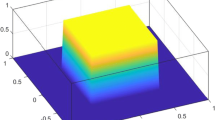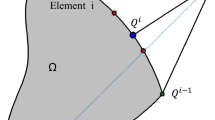Abstract
In this paper, we introduce a semi-Lagrange scheme to solve the level-set equation in structural topology optimization. The level-set formulation of the problem expresses the optimization process as a solution to a Hamilton–Jacobi partial differential equation. It allows for the use of shape sensitivity to derive a speed function for a descent solution. However, numerical stability condition in the explicit upwind scheme for discrete level-set equation severely restricts the time step, requiring a large number of time steps for a numerical solution. To improve the numerical efficiency, we propose to employ a semi-Lagrange scheme to solve level-set equation. Therefore, a much larger time step can be obtained and a much smaller number of time steps are required. Numerical experiments comparing the semi-Lagrange method with the classical explicit upwind scheme are presented for the problem of mean compliance optimization in two dimensions.
Similar content being viewed by others
References
Allaire G, Kohn RV (1993) Topology optimization and optimal shape design using homogenization. In: Bendsoe MP, Moa Soares CA (eds) Topology design of structures, NATO ASI Series, Series E, vol 227. Kluwer, Dordrecht, pp 207–218
Allaire G, Jouve F, Taoder A-M (2002) A level-set method for shape optimization. C R Math Acad Sci Paris Ser I 334:1125–1130
Allaire G, Jouve F, Taoder A-M (2004) Structural optimization using sensitivity analysis and a level-set method. J Comput Phys 194(1):363–393
Bendsoe MP (1989) Optimal shape design as a material distribution problem. Struct Optim 1:193–202
Bendsoe MP (1997) Optimization of structural topology, shape and material. Springer, Berlin Heidelberg New York
Bendsoe MP, Haber R (1993) The Michell layout problem as a low volume fraction limit of the homogenization method for topology design: an asymptotic study. Struct Optim 6:63–267
Bendsoe MP, Kikuchi N (1988) Generating optimal topologies in structural design using a homogenisation method. Comput Methods Appl Mech Eng 71(1–2):197–224
Bendsoe MP, Sigmund O (1999) Material interpolations in topology optimization. Arch Appl Mech 69:635–654
Courant R, Isaacson E, Rees M (1952) On the solution of nonlinear hyperbolic differential equations by finite differences. Commun Pure Appl Math 5:243
Diaz AR, Bendoe MP (1992) Shape optimization of structures for multiple loading conditions using a homogenization method. Struct Optim 4:17–22
Harten A, Engquist B, Osher S, Chakravarthy S (1996) Uniformly high order essentially non-oscillatory schemes, III. J Comput Phys 74:347–377
Hintermüller M, Ring W (2003) A second order shape optimization approach for image segmentation. SIAM J Appl Math 64(2):442–467
Mlejnek HP (1992) Some aspects of the genesis of structures. Struct Optim 5:64–69
Osher S, Fedkiw R (2003) Level set methods and dynamic implicit surfaces. Springer, Berlin Heidelberg New York
Osher S, Santosa F (2001) Level set methods for optimization problems involving geometry and constraints. I. Frequencies of a two-density inhomogeneous drum. J Comput Phys 171(1):272–288
Osher S, Sethian JA (1988) Front propagating with curvature-dependent speed: algorithms based on Hamilton–Jacobi formulations. J Comput Phys 79(1):12–49
Reynolds D, McConnachie J, Bettess P, Christie WC, Bull JW (1999) Reverse adaptivity—a new evolutionary tool for structural optimization. Int J Numer Methods Eng 45:529–552
Ritchie H (1986) Eliminating the interpolation associated with the semi-Lagrangian scheme. Mon Weather Rev 114:135–146
Rozvany GIN (1988) Structural design via optimality criteria. Kluwer, Dordrecht
Sethian JA (1999) Level set methods and fast marching methods: evolving interfaces in computational geometry, fluid mechanics, computer vision, and material science. Cambridge University Press, Cambridge
Sethian JA, Wiengmann A (2000) Structural boundary design via level set and immersed interface methods. J Comput Phys 163(2):489–528
Shu CW (1998) Essentially non-oscillatory and weighted essentially non-oscillatory schemes for hyperbolic conservation laws. In: Cockburn B, Johnson C, Shu CW, Tadmor E (eds) Advanced numerical approximation of nonlinear hyperbolic equations, vol 1697. Springer, Berlin Heidelberg New York, pp 325–432 (Lecture Notes in Mathematics)
Smolarkiewicz PK, Pudykiewicz J (1992) A class of semi-Lagrangian approximations for fluids. J Atmos Sci 49:2082–2096
Staniforth A, Côté J (1991) Semi-Lagrangian schemes for atmospheric models—a review. Mon Weather Rev 119:2206
Strain J (1999) Semi-Lagrange methods for level set equations. J Comput Phys 151(2):498–533
Strain J (2000a) A fast modular semi-Lagrange method for moving interfaces. J Comput Phys 161(2):512–536
Strain J (2000b) Tree methods for moving interfaces. J Comput Phys 151(2):616–648
Suzuki K, Kikuchi N (1991) A homogenization method for shape and topology optimization. Comput Methods Appl Mech Eng 93(1–2):291–381
Wang MY, Wang XM (2004) Color level sets: a multi-phase method for structural topology optimization with multiple materials. Comput Methods Appl Mech Eng 193(6–8):469–496
Wang MY, Wang XM (2005) A level-set based variational method for design and optimization of heterogeneous object. Comput Aided Des 37(3):321–337
Wang MY, Wang XM, Guo DM (2003) A level set method for structural topoloty optimization. Comput Methods Appl Mech Eng 192(1):227–246
Wang XM, Wang MY, Guo DM (2004) Structural shape and topology optimization in a level-set framework of region representation. Struct Multidiscipl Optim 27(1–2):1–19
Xie YM, Steven GP (1993) A simple evolutionary procedure for structural optimization. Comput Struct 49:885–896
Author information
Authors and Affiliations
Corresponding author
Rights and permissions
About this article
Cite this article
Xia, Q., Wang, M.Y., Wang, S. et al. Semi-Lagrange method for level-set-based structural topology and shape optimization. Struct Multidisc Optim 31, 419–429 (2006). https://doi.org/10.1007/s00158-005-0597-y
Received:
Revised:
Published:
Issue Date:
DOI: https://doi.org/10.1007/s00158-005-0597-y




